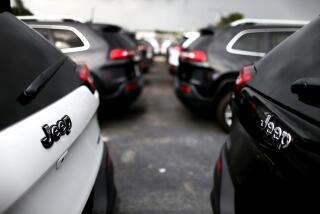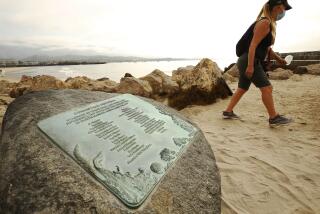Boeing, NTSB probe airport grass fire sparked by 787 jet engine
After a jet engine sparked a grass fire at a South Carolina airport, Boeing Co. is again investigating its problem-plagued 787 Dreamliner passenger aircraft.
The fuel-efficient Dreamliner, which debuted last year, has been beset by delays and production glitches in recent years. But investigators and analysts said it was too early to blame the latest incident on the jet engines, made by General Electric Co. and dubbed GEnx engines.
The National Transportation Safety Board sent an investigator to determine whether the incident was serious enough to warrant a formal inquiry, said spokesman Terry Williams.
“It’s not unusual for us to look at a particular event like this and gather information,” he said. “It’s the investigator’s first full day at the scene.”
The fire occurred Saturday while the jet was undergoing preflight runway testing at Charleston International Airport in Charleston, S.C. Although the airport shut down briefly, there were no injuries.
The GEnx engines first entered service on a cargo-carrying version of Boeing’s 747 jumbo jet in October and began flying on the Dreamliner in April. In a statement, the company said “this incident has not happened before” with its GEnx engines.
GE said about 80 of the new engines are in service, and they have accumulated more than 125,000 flight hours.
“GE continually monitors and analyzes the performance of the GEnx fleet in service, and we are not aware of operational issues that would affect the continued safe flight of aircraft powered by these engines,” the company said.
The Dreamliner, a twin-aisle aircraft that seats 210 to 290 passengers, made its first passenger flight with Japanese carrier All Nippon Airways in October. Boeing delivered the plane more than three years late because of design problems and supplier issues.
It is the first large passenger jet with more than half its structure made of composite materials (carbon fibers meshed together with epoxy) instead of aluminum sheets. Major parts for the plane are pre-assembled elsewhere and then shipped to Everett, Wash., where they are “snapped together” in three days, compared with a month the traditional way.
Chicago-based Boeing says the Dreamliner burns 20% less fuel than jetliners of a similar size.
Through June, the aerospace giant had taken 859 orders for the Dreamliner from airlines and aircraft leasing firms around the world. Depending on the version of Dreamliner ordered, the plane costs $193.5 million to $227.8 million.
“Boeing is changing the way an aircraft is produced, and it carries radical new technology never used before,” said Michel Merluzeau, managing partner of aerospace consultant G2 Solutions in Kirkland, Wash. “There were bound to be problems.”
The problems continue to mount. Shortly after delivery of the first aircraft, All Nippon Airways reported a problem with landing gear. In March, Boeing had to slow Dreamliner deliveries because the sheets of laminated composite materials that make up the plane’s body were separating.
Just last week, five of Japanese carrier All Nippon Airways’ 787 Dreamliner commercial airplanes were grounded because of corrosion found during testing in jet engines made by Rolls Royce. Boeing believed the problem could be traced to changes to a manufacturing process.
Richard Aboulafia, an aerospace analyst with Teal Group Corp., a Virginia research firm, said the engine incident in Charleston is unlikely to have been caused by a design flaw.
“These engines have been certified and flying for some time now,” Aboulafia said.
The incident, he said, appears more likely to have been caused by a worker’s leaving a part behind or a foreign object finding its way into the engine and then firing into the grass.
Engine failures do happen. In November 2010, a Rolls Royce engine exploded on an Airbus A380 super jumbo jet operated by Australian carrier Qantas Airways. In a report, the Australian Transport Safety Bureau said that an oil pipe in the engine was too thin and caused a fracture, allowing oil to leak and ignite. The airline has since replaced the engines.
Nancy Castles, a spokeswoman for Los Angeles’ airport agency, Los Angeles World Airports, said engine failure was a rare occurrence at Los Angeles International Airport. It didn’t happen once last year in 604,000 takeoffs and landings at LAX, she said.
The National Transportation Safety Board does not know when it will complete its work on the recent incident in Charleston because it’s so early in the information collecting process.
In the meantime, the GEnx engines will continue to fly.
“Boeing and GE are working closely with the NTSB and are committed to resolving the issue appropriately,” Boeing spokesman Scott Lefeber said in a statement. “Should the investigation determine a need to act, Boeing has the processes in place to take action and will do so appropriately.”
More to Read
Inside the business of entertainment
The Wide Shot brings you news, analysis and insights on everything from streaming wars to production — and what it all means for the future.
You may occasionally receive promotional content from the Los Angeles Times.











